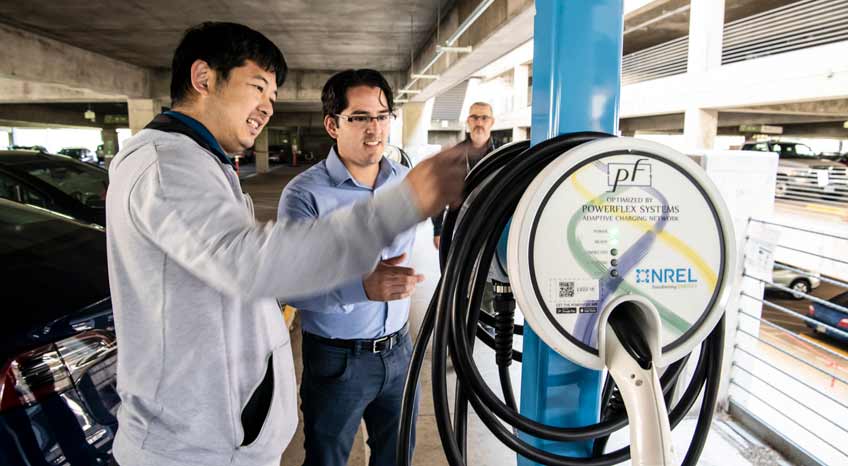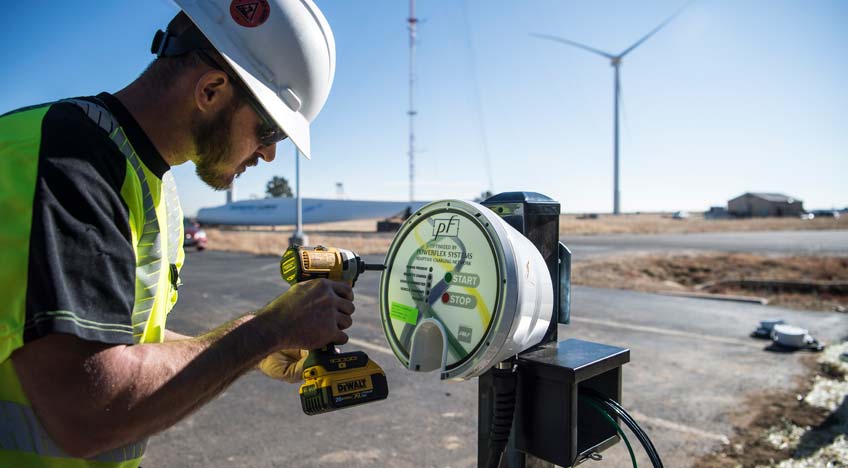NREL’s ‘Living Laboratory’ Provides Steppingstones to Real-World Impact
Lab Validates Electric Vehicle Charging Tech with Potential to Help the Grid

The number of electric vehicles (EVs) on roadways worldwide is increasing. In the United States alone, EV volume grew by an average of 32% annually between 2012 and 2016. Globally, EVs are projected to reach 35 million by 2022.
To many, this is good news. But it comes with a significant challenge: developing and deploying low-cost solutions for public EV charging infrastructure. Ideally, many EVs will have flexible charging schedules: plugging in at work in the morning, then plugging in again at home in the evening. This will help spread the charging load throughout the day and avoid "peak events" in the early evening hours. If left unmanaged, however, peak events will only grow, leading to the need for additional investment in grid management and, ultimately, increasing the cost of energy.
Finding solutions to such complex challenges is what the U.S. Department of Energy's (DOE's) National Renewable Energy Laboratory (NREL) was designed for, not just in terms of its research mission, but also in how it conducts its operations and manages its physical space. NREL’s Intelligent Campus program promotes the laboratory itself as a research instrument, a “living laboratory” that allows NREL and its partners to study the integration of renewable energy and energy efficiency technologies.
One partner, PowerFlex, has been working with NREL on all of these levels to address the EV charging challenge. With NREL technical assistance and commercialization resources, the startup’s promising technology is on its way to help prevent energy-management issues as more EVs hit the road.

Living Laboratory and Beyond
NREL’s living laboratory works a lot like other energy systems: it integrates power from various sources (including solar panels and other on-campus energy generation technology) and addresses a range of energy needs, such as EV charging for staff and visitors. A team including both researchers and operations staff manages the system, determining how to balance the load and get it as close to net-zero as possible, with the laboratory generating as much energy as it uses.
But NREL’s energy demand, like that of other systems, can change drastically over the course of a day. “When the laboratory experiences a peak event, it has to pay more to get electricity from the grid,” explained Senior Research Engineer Andrew Meintz.
The PowerFlex adaptive charging network has helped NREL’s Flatirons Campus (near Boulder, Colorado) address this challenge, and is now being installed at NREL’s South Table Mountain (STM) Campus in Golden, Colorado. The “smart” EV-charging system is designed to dynamically adapt to changing electrical demands and conditions. Unlike traditional charging systems, which charge all connected vehicles at the same electrical current, the PowerFlex system “shares” the load. It uses an algorithm that adjusts the speed of the charge based on several factors, such as the number of vehicles plugged in at any given time, other energy demands on the system, and available power from different energy sources.
“One thing that’s unique about the PowerFlex approach is that it recognizes the value of managed charging,” explained Intelligent Campus Project Leader Lissa Myers. “Another is that its network, by sharing the load, helps reduce the amount of electrical infrastructure that’s required. For commercial buildings and campuses, this can mean significant reductions in costs and increases in energy efficiency.”
In studying how the PowerFlex system works at NREL, the laboratory not only realizes energy and cost savings—it is also able to identify possible solutions for other campuses and even larger integrated energy systems such as the grid. But to most accurately extrapolate NREL’s results into predictions for larger systems, another important factor must be considered: user behavior. This is where the PowerFlex smartphone app comes in.
“Currently adopted EV technology standards don’t allow for detailed communication between the vehicle and the charging infrastructure,” Meintz said. “The introduction of an app that asks the user questions about their charging is a unique aspect of this project that bring humans into the process. At the end of the day, the data you really want is what’s in the brain of the user. You want to know when they’re unplugging the car and driving away—the car can’t tell you that.”
Through the app, each of NREL’s EV drivers tells the system how much charge they need to get home and when they plan to leave the laboratory that day. The PowerFlex algorithm then determines—based on this data and the campus’s real-time energy demand and generation—the most efficient way to charge all the connected vehicles. The more flexibility the user gives the system (i.e., the wider the time window and the smaller the charge needed) the less the user has to pay for the charge.
If the approach works at NREL, that will increase researchers’ confidence of its ability to work elsewhere. And if adopted by other large charging networks, the approach could be a lifesaver for the grid. “We think there could be a huge benefit to the grid as a whole by spreading EV charging throughout the day,” Meintz said.

Steppingstones to Market
The partnership between NREL and PowerFlex has resulted in a wealth of benefits for the startup, too, through several of the laboratory’s research and commercialization steppingstones for promising renewable energy and energy efficiency technologies. One is the Wells Fargo Innovation Incubator (IN2) program, which is operated and administered by NREL’s Innovation and Entrepreneurship Center. IN2’s commercial buildings program speeds the path to market for promising early-stage cleantech companies by providing funding and NREL technical assistance.
“We go on a journey with these startups,” said NREL IN2 Program Manager Trish Cozart. “What makes IN2 a different kind of incubator is our focus isn’t recouping a monetary business investment. The main driver is finding technologies with the potential to positively impact the use of energy and validate the tech at the lab. This catalyzes the company's speed to market, and at scale, where they can deliver that impact."
IN2 has awarded approximately $250,000 to each of 30 startups since it launched in 2014, with companies sometimes receiving additional follow-on funding or beta demonstration support. But perhaps the most telling sign of its success is the fact that its graduates have gone on to raise $174 million in additional funding outside the program. It is estimated that, for every dollar IN2 invests, its portfolio companies go on to raise more than $20 in external funding.
But funding is just the first step. The program also facilitates demonstration and validation of the funded technologies in real-world environments—hence the initial PowerFlex demonstration at NREL’s Flatirons Campus, which has a higher-than-average staff EV adoption rate. NREL installed 16 charging stations managed by the PowerFlex adaptive charging network for use by employees, and PowerFlex used the resulting data to improve and develop its product.
The demonstration was so beneficial for both PowerFlex and NREL that the startup was able to take advantage of another steppingstone: the laboratory’s Small Business Program, part of which aims to direct 59% of NREL’s annual procurement to small businesses. When the laboratory decided to purchase the 16 Flatirons-Campus chargers plus an additional 108 for its STM campus in Golden, Colorado, PowerFlex was the successful bidder (as was another small business, St. Andrew’s Construction Services, which was selected to install the chargers).
“Small businesses are a smart choice for NREL,” said Rexann Dunn, who leads NREL’s Small Business Program. “They deliver a degree of personalization, service, and innovation that can be difficult to find in larger companies. When we help them grow, they, in turn, help us deliver on our mission.”
“This is the quintessential example of what we want to happen through IN2: for a startup to enter the program, validate and de-risk its technology with NREL’s help, then start closing deals to get their product to the customer,” Cozart said. “In this case, NREL just happened to be a customer, too.”
Many IN2 companies have also made successful exits in the form of mergers and acquisitions; PowerFlex was recently acquired by a major renewable-energy producer and service provider.
“We were thrilled with the R&D funding and the opportunity to work with NREL,” said PowerFlex Founder and Chief Technology Officer George Lee. “Combining the installations at the two NREL campuses, NREL’s EV charging system will be Powerflex’s largest installation outside of California and its largest government installation.”
When it comes to our energy future, like mist clearing from a river, the direction we need to go and the path we take to get there are becoming increasingly clear. And each time NREL guides promising companies and technologies from one steppingstone to the next in its living laboratory, it continues to solidify that path, which others will eventually take—joining the laboratory and its partners in an energy transformation already well underway.
Learn more about NREL’s EV Grid Integration research.
Last Updated May 28, 2025
